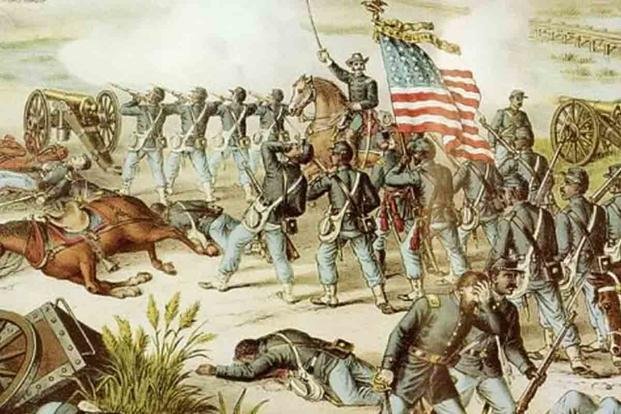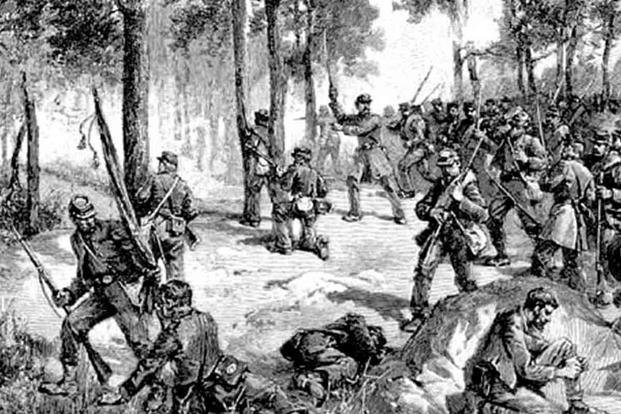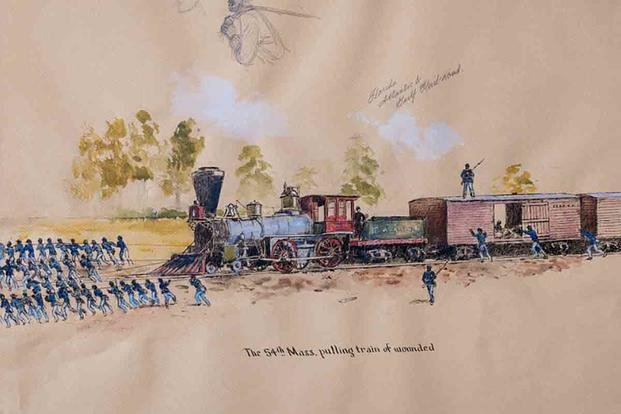
By Blake Stilwell
The 1989 film “Glory” was both an awesome movie and a (relatively) faithful depiction of the all-Black 54th Massachusetts Infantry Regiment, culminating with the unit’s stunning assault on Confederate-held Fort Wagner at the height of the Civil War. But as great as it is, the movie stops short of what might be the 54th’s finest hour: The Battle of Olustee, or more specifically, the aftermath of the battle that saw Black soldiers haul a stalled train by hand for 13 miles.
To understand the Battle of Olustee, you have to understand Florida’s place in the conflict. The state’s primary contribution to the Confederacy wasn’t necessarily men — it only contributed some 15,000 troops, compared to more than 100,000 supplied by both Virginia and Tennessee during the course of the conflict — but something equally important: food. Indeed, the capture of Vicksburg in 1863 cut the western Confederate states off from the rest of the South, which meant Florida’s beef and salt supplies not only became twice as important, but they made Florida a target for the Union Army.
Early on in the war, Florida’s coastal areas were occupied by Union forces. The Confederates there were more interested in protecting its inland farms, which were far more important for the war effort. Aside from some small meetings between northern and southern forces, there weren’t many pitched battles on Florida soil. The exception would come in 1864, when the two sides met at Olustee.
In February 1864, a 5,500-strong Union force under Gen. Truman Seymour (who commanded the assault on Fort Wagner) landed in Jacksonville with the mission of cutting off Florida as a rebel food supply, setting up a pro-Union government and enlisting Black soldiers. Almost immediately, Seymour advanced against Confederate troops, militias and farms further inland; then, he started going farther than his orders, heading directly for the state capital.
Marching along the Florida Central and Western Railroad, Seymour continued his stated mission while pushing toward Tallahassee. The rebels were ready for him, however, and as his force reached Ocean Pond, Florida, on Feb. 20, 1864, he was met by 5,000 Confederate troops. The resulting battle was evenly matched, and both sides suffered heavily under enemy fire.

At the end of the fighting, the rebels would suffer 19% casualties, compared to the Union’s staggering 34%. The Union also lost six guns, and the Confederates captured dozens of its horses. It would be the second-bloodiest battle of the war for the Union. Most importantly, the Union was forced to retreat.
The Confederate Army held back from pursuing the Union force, but when it finally attacked the retreating column, the rebels were pushed back to their lines by the Union rearguard, made up of an unforgiving combination of the 35th U.S. Colored Troops and the 54th Massachusetts.
Two days later, the defeated Federals were still marching the 46 miles back to Jacksonville when Seymour got word that the train carrying most of the wounded from Olustee had stopped due to a broken locomotive. Fearing the Union wounded would be captured by pursuing rebel forces, the 54th Massachusetts doubled back to the train. They used ropes to pull the train by hand three miles to Camp Finegan, where they got horses to help. From there, the men and horse pulled the wounded 10 more miles to the safety of Jacksonville over the course of 42 hours.
Capt. Luis F. Emilio, a commander in the unit, would write a history of the 54th Massachusetts in 1891. When describing its actions after the Battle of Olustee, he wrote:
“Through eagerness to escape the supposed pursuing enemy, too great pressure of steam was employed, and the flue collapsed; and here the immortal Fifty-fourth [colored] did what ought to insure it higher praise than to hold the field in the face of a victorious foe, — with ropes it seized the engine [now useless] and dragged it with its doomed freight for many miles. They knew their fate if captured; their humanity triumphed. Does history record a nobler deed?”

The only major Civil War battle in Florida was a rout for the Union, but it might have been a lot worse if more than a thousand wounded soldiers had fallen into the hands of rebel troops. It wasn’t the pitched battle ending the movie “Glory” offered, but the daring rescue meant hundreds of Union troops would fight another day.





